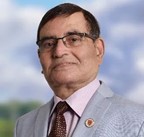
各位老师、同学,各位学者,
兹定于近期邀请IEEE Life Fellow, D.V. Giri博士分别以“Design and Evaluation of Simple Electrical Circuit Components (R, L and C) for High-Voltage and High-Frequency Applications”、“Therapeutic and Diagnostic Uses of EM Energy in Emerging Medical Technologies”、“Short Pulse Technologies with Illustrative Applications”为主题做线上学术报告。有关报告信息通知如下。
Speaker:D. V. Giri
01
Talk 1:Design and Evaluation of Simple Electrical Circuit Components (R, L and C) for High-Voltage and High-Frequency Applications
Beijing Time:18:30pm-20:30pm,Dec.22, 2021
Voov Meeting ADD:https://meeting.tencent.com/dm/R38rDaNan9VP
Code:596-875-207
02
Talk2:Therapeutic and Diagnostic Uses of EM Energy in Emerging Medical Technologies
Beijing Time:18:30pm-20:30pm,Dec.23, 2021
Voov Meeting ADD:https://meeting.tencent.com/dm/pX9ZkfdwbiqZ
Code:930-351-507
03
Talk 3:Short Pulse Technologies with Illustrative Applications
Beijing Time:10:10am-12:00am,Dec. 24, 2021
Voov Meeting ADD:https://meeting.tencent.com/dm/SThgCDUxHjph
Code:843-874-876

Biography:
Dr. Giri has 45 years of work experience in the general field of electromagnetic theory and its applications in NEMP (Nuclear Electromagnetic Pulse), HPM (High-Power Microwaves), Lightning, and UWB (Ultra Wideband). A complete description of his academic training and work experience may be seen at his website: www.dvgiri.com
He obtained the B.Sc., Mysore University, India, (1964), B.E., M.E.,Indian Institute of Science, (1967) (1969), M.S., Ph.D., Harvard University, (1973) (1975), Certificate, Harvard Introduction to Business Program, (1981).
LIFE FELLOW of IEEE, IEEE EMC Society – Distinguished Lecturer(2020-2021)
He has also published over 200 papers, reports etc.
He is a Co-Editor with Prof. Raj Mittra, and they have started an on-line Forum and Journal on Electromagnetics called FERMAT(www.e-fermat.org).
Abstract:
Talk 1: Design and Evaluation of Simple Electrical Circuit Components (R, L and C) for High-Voltage and High-Frequency Applications
Resistors, Inductors and Capacitors are common electrical circuit elements. They are easy to design and readily available for use at low frequencies (up to a few MHz). As we increase the frequency to 10’s and 100’s of MHz, these elements tend to have complex equivalent circuits. New approaches are needed to make them work efficiently at high-frequencies. In addition, in high-power EMs (HPE) applications, we are also concerned about arcing and breakdown issues within and across these components. In this talk, we review certain methods of building electrical components (R, L and C) specifically for HV and HF applications. It is well known that high-frequencies and high-voltages impose conflicting requirements. High-voltage applications require increased inter-electrode distances, while high-frequency operation requires dimensions to be small. If we consider the feed point of an antenna, high-voltage argues for more space, while high-frequencies require smaller spaces. Furthermore, we require R, L and C elements for many HPE applications such as elements of pulse-shaping networks and terminators for transmission lines. They are also needed in the design of high-performance EMC filters. In this presentation, we discuss how R, L and C elements can be built for both high voltage and high-frequency applications.
Talk 2: Therapeutic and Diagnostic Uses of EM Energy in Emerging Medical Technologies
In this presentation, we review the medical uses of EM energy in both diagnosis and therapy. The EM spectrum ranging from DC to Gamma rays and beyond is a vast natural resource that has been very valuable for humankind. With the rapid advances of medical technology, Radio Frequency (RF) techniques are becoming increasingly popular for a variety of applications such as non-invasive diagnosis, continuous monitoring of physiological data, communication between implanted devices, and communication to external devices. Therapeutic applications of EM energy can be broadly classified into two groups as (1) conventional and (2) emerging therapies. Examples of conventional therapies are:a) hyperthermia (thermal therapy), b) MRI, c) X-ray and d) CT scan. In the emerging category are a) THz Imagery and b) implantable devices. Medical applications are possible at many frequencies such as DC, RF, Microwave, X rays and Gamma rays. In the past decade there have been some remarkable strides made by EM applications implemented in medical technologies. This talk summarizes some significant developments with EMs in emerging medical technologies.
Talk 3: Short Pulse Technologies with Illustrative Applications
Parabolic mirrors are useful in radiating impulse-like waveforms. The antenna subsystem consists of a paraboloidal-reflector illuminated by a pair of conical transmission lines. Because of the spherical TEM feed, this antenna is non-dispersive. For an applied fast-rising voltage function, the radiated electric field spectrum is flat over two decades of frequencies. Some fundamental differences between frequency independent antennas (ex: log-periodic dipoles) and the present non-dispersive time-domain antennas will be discussed. Familiar concepts such as antenna gain and radiation pattern need to be redefined for time-domain antennas. Design, fabrication, working principles and performance of this class of antennas are discussed. Such a radiating system has resulted in an emerging technology with many military and civilian applications, some of which will also be discussed.
欢迎各位参加。
